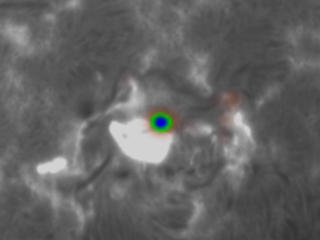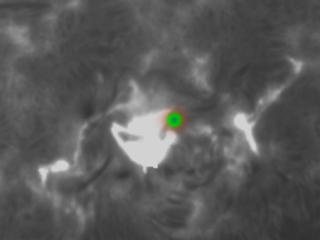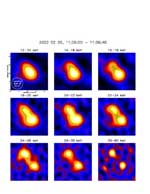NASA CELEBRATES SUN-EARTH DAY WITH SOLAR X-RAY FIREWORKS
March 20, 2002 - (date of web publication)
|
Image 1
Click here for movie 1 |
Image 2
Click here for movie 2 |
Image 3
Click here for movie 3 |
|
Caption for all movies: HESSI aims to provide the first-ever opportunity to track the radiation released by solar flares in X-ray and gamma rays. This radiation is what reveals critical information about the flare: the exact time and place where the energy is released. This can help to understand what triggers a flare and how it releases energy. This moderately powerful Feb. 20 flare is first seen in the movie by the Solar and Heliospheric Observatory (SOHO). Color-coded HESSI data is then super-imposed on black & white images delivered by ground-based telescopes at the Big Bear Observatory; blue shows the most intense X-ray emissions and red the weakest. During the flare, the X-rays are generated by electrons accelerated to half the speed of light. Because the flare was relatively weak, there were no gamma rays observed that would have shown high-energy protons. This view is near a large sunspot region that produced a series of solar flares. |
||
Just in time for Sun-Earth Day, a new NASA spacecraft, complete with a new name, made its debut by observing a huge explosion in the atmosphere of the Sun. The blast, called a solar flare, was equal to one million megatons of TNT and gave off powerful bursts of X-rays.
The solar fireworks were captured by what is now known as the Reuven Ramaty High-Energy Solar Spectroscopic Imager spacecraft, or RHESSI. The spacecraft launched last month as HESSI was recently renamed in honor of Dr. Reuven Ramaty, who died in 2001 after a long and distinguished career in the Laboratory for High Energy Astrophysics at the NASA Goddard Space Flight Center, Greenbelt, Md. Ramaty was a pioneer in the field of solar-flare physics, gamma-ray astronomy and cosmic rays.
"We are thrilled to be making the first high-resolution movies of flares using their high-energy radiation," said Brian Dennis, the RHESSI mission scientist at Goddard. "We want to understand how solar flares can explosively release so much energy. RHESSI shows us the high-energy radiation emitted by flares: their X-rays and gamma rays. This radiation reveals the core of the flare -- the exact time and place where the energy is released."
Today is the second annual Sun-Earth Day, which is sponsored by NASA's Sun-Earth Connection Education Forum to provide an opportunity to learn more about the Sun's connection to the Earth through images, cultural parallels and activities. Powerful events on the Sun, including flares, occasionally disrupt satellites and communications and power systems.
Scientists believe solar flares are powered by the violent release of magnetic energy, but how this happens is unknown. A new movie features one of the first flares recorded by RHESSI, which occurred Feb. 20 in the southern hemisphere of the Sun, an active region designated "AR 9830."
|
Image 4
Click on image to enlarge. |
Caption for Image 4: Array of nine X-ray images of a solar flare that occurred on 20 February 2002 at 11:06 UT. The color represents the intensity of the X-rays with white being most intense and black being least intense. The X-ray energy range is shown above each picture in kilo-electron volts. The exposure time was 39 seconds loop. These images tell us what is happening at the core of the flare where the energy is released from the coronal magnetic field and electrons are accelerated to near the speed of light. We see that the X-ray source at the lowest energies (12 - ~16 keV, top left image) is just a single blob. We believe that this emission is from hot plasma confined in a magnetic loop. At higher energies (30 - 80 keV, bottom right image), the source breaks up into two distinct bright regions. This we think is from electrons that have been accelerated during the flare as they lose their energy in the denser regions of the lower solar corona and chromosphere. These images help us to understand where and how the tremendous energy of a solar flare is released so rapidly. CREDIT: NASA |
It was a moderately powerful flare, classified as M2.4 by the National Oceanic and Atmospheric Administration (NOAA). The most powerful flares, designated X-class by NOAA, can release up to 100 times more energy.
During its planned two-year mission, RHESSI will study the secrets of how solar flares are produced in the Sun's atmosphere. Launched Feb. 5, RHESSI is now fully operational after only six weeks in orbit. It is observing the Sun and recording the high-energy radiation from solar flares as they occur.
RHESSI is the first NASA Small Explorer mission being managed in the "Principal Investigator" mode. The Principal Investigator, Robert Lin of the University of California, Berkeley, is responsible for many aspects of the mission, including the science instrument, spacecraft integration and environmental testing, and spacecraft operations and data analysis.
|
Image 5
Click on image to enlarge. |
Caption for Image 5: Spectra of the same flare shown in Image 4. Plotted is the X-ray photon flux from the flare as a function of the photon energy in keV. The spectra shown in blue and red are from the separated blobs at higher energies shown in Image 4. They form a straight line on this log-log plot indicating that the X-rays from these two bright patches are generated by electrons accelerated to over half the speed of light during the flare. The spectrum shown as the solid black line is for the region between the two blobs seen at the higher energies in Image 4. The steeper slope of this spectrum and its curvature suggest that this X-ray emission is from a plasma heated to many tens of millions of degrees Kelvin during the flare. This information provides more insight into how the flare heats plasma to such high temperatures and accelerates so many particles to such high speeds in such a short time. CREDIT: NASA |
The RHESSI scientific payload is a collaborative effort among the University of California, Berkeley; Goddard; the Paul Scherrer Institut in Switzerland; and the Lawrence Berkeley National Laboratory in Berkeley. The mission also involves additional scientific participation from France, Japan, The Netherlands, Scotland and Switzerland.
The Explorers Program Office at Goddard manages the RHESSI mission for NASA's Office of Space Science in Washington. Spectrum Astro, Inc. of Gilbert, Ariz., constructed the RHESSI spacecraft and provided integration support.
High
resolution of Image 1
High
resolution of Image 2
High
resolution of Image 3
High
resolution of Image 4
High
resolution of Image 5




